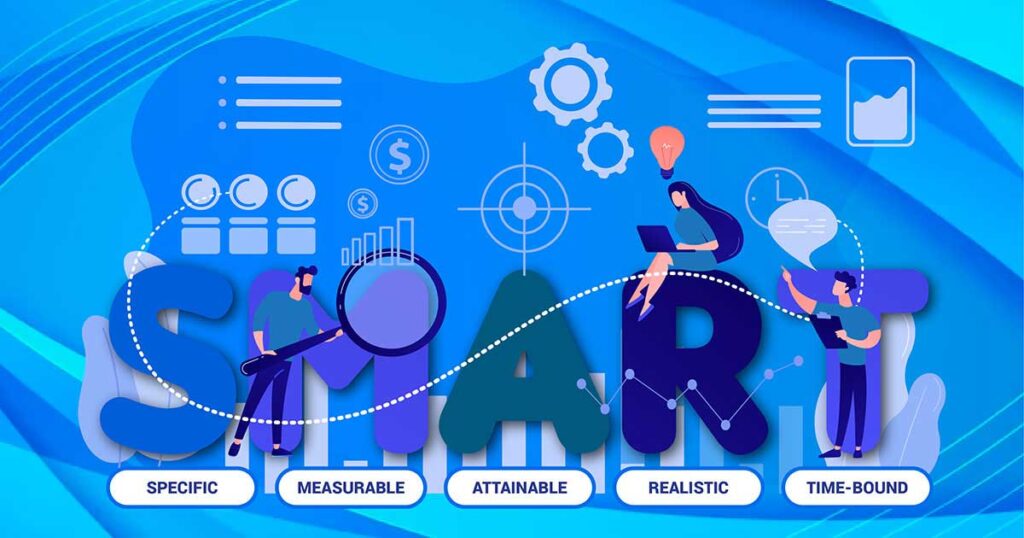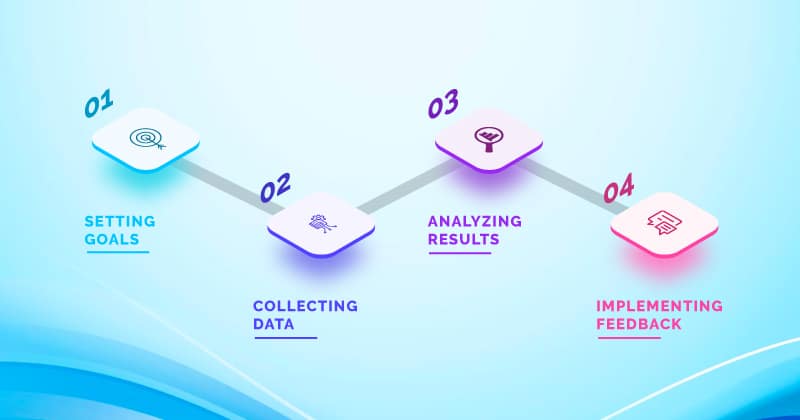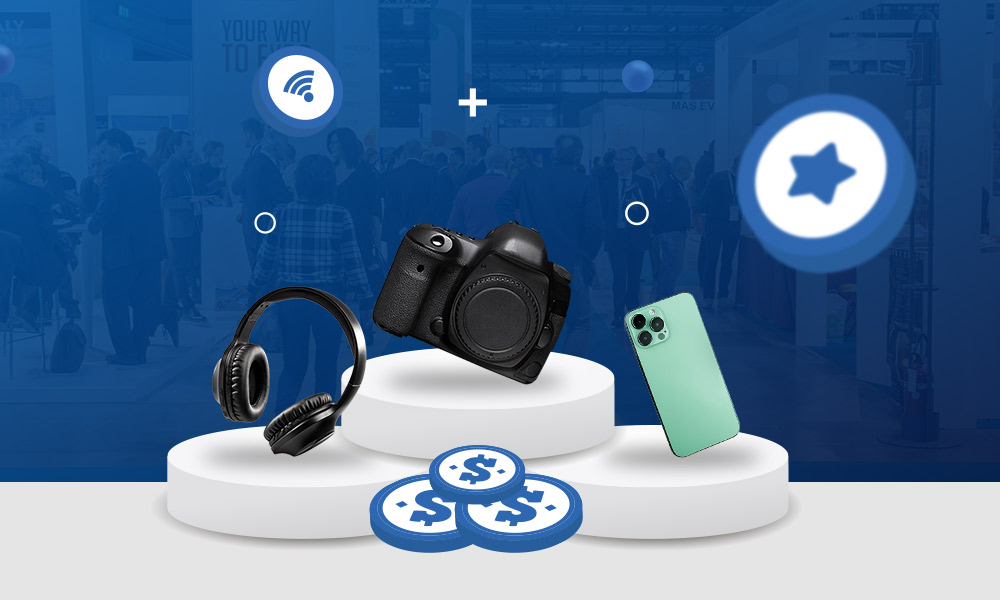How to Measure Trade Show Effectiveness

Understanding how to measure trade show effectiveness is crucial for businesses aiming to maximize their ROI from B2B expos. It’s not just about participation; it’s about evaluating the impact of your involvement.
Did your efforts make a significant difference, or was there room for improvement? This guide will equip you with essential strategies and insights to assess the true value of your trade show participation.
We’ll dive into capturing valuable leads, enhancing your brand’s lasting impact, and analyzing key metrics to reveal the real success of your trade show endeavors. Prepare to refine your approach and secure measurable triumphs at your upcoming events.

Understanding the Role of Trade Shows in B2B Marketing
In the world of B2B, trade shows are the ultimate arena for networking, making your brand known, and snagging leads. Picture a vibrant marketplace, each handshake a seed for new partnerships, and every chat a door to potentially huge opportunities. For businesses in the B2B sector, these gatherings are far more than just a showcase; they’re a critical battleground for gaining visibility and forging connections.
Yet, the tale has a twist: the allure of trade shows goes beyond just the brightest booths or most excellent giveaways. With the business environment ever-changing beneath us, trade shows are also transforming.
They’re now a mix of old-school face-to-face interactions with digital innovations. Imagine showing off your new products with virtual reality, buzzing live feeds on social media, and specialized apps that elevate the in-person experience. This new hybrid approach does more than break the boundaries of the convention center; it’s redefining our approach to engagement and success in the B2B sphere.
So, as we navigate the dynamic world of trade shows, it’s clear: it’s not enough to just be there. It’s about shining brighter, forging genuine bonds, and blending the traditional with the new to mark your territory in the marketplace. In this changing landscape, the mantra for the forward-thinking marketer is to adapt, connect, and surpass.
Key Metrics on How to Measure Trade Show Effectiveness

Trade shows can pump you up, no doubt. Seeing your booth swarmed with people is a rush. But here’s the thing – the real win isn’t just about feeling good in the moment. It’s about what the data tells you afterward.
So, how do we move past the excitement to the stuff that shows us how well we did? Let’s walk through the essential stats that spell out the success of a trade show, and let’s keep it straightforward and real:
Leads Generated
It’s not just about collecting business cards; it’s about qualifying those trade show leads. Was the person you chatted with genuinely interested, or were they passing by for the freebies? It’s crucial to differentiate between the two. A good chat can sometimes be more valuable than a hundred indifferent handshakes.
Cost Per Lead
It’s time to grab your calculators, folks. This is the part where we break down what each interaction at the trade show costs you. Take the expense of attending the trade show and divide it by the number of solid leads you walked away with. This calculation will show whether those handshakes were golden opportunities or just shiny distractions.
Sales Conversion Rate
This is the ultimate test, turning leads into actual sales. This metric is the heartbeat of your trade show strategy, indicating how effectively you’re converting prospects into buyers.
Booth Traffic
It’s not just about the quantity but the quality of visits. Tracking foot traffic can help you understand peak times and visitor engagement levels.
Social Media Engagement
It plays a massive role, too. Did your hashtag gather dust, or did it create a storm? Online interactions can amplify your trade show presence beyond the convention center.
Brand Awareness
It is a bit trickier to measure but just as important. It’s about whether more people know about your brand post-show and if they perceive it positively.
Win Rate and Meetings Per Deal Closed
This metric evaluates the success of your trade show meetings. It determines whether discussions led to deals or were simply conversations. It links your effort, investment, and the real business opportunities gained.
Advanced Metrics for In-Depth Analysis

Diving deeper into the sea of trade show metrics, let’s get real about what it takes to understand the impact of your trade show efforts truly. It’s like peeling back the layers of an onion – the more you peel, the more it stings, but that’s where the flavor is. So, let’s talk about the more nuanced metrics that give us the full taste of trade show success:
Cost Per Qualified Lead (CPQL)
Here’s where it heats up. It’s not just a game of how many leads you’ve collected but more about determining valuable ones. This measure lets you sift through the crowd, separating the genuinely interested prospects from the just-browsing ones. It’s like going from simply tallying up numbers to focusing on the numbers that truly matter—spotting the leads ready to move forward.
Return on Investment (ROI)
This is the big Kahuna. Calculating ROI is like checking your receipt after a shopping spree; it tells you if you got bang for your buck. By comparing the cost of your trade show participation against the actual revenue generated, you get a crystal-clear picture of whether the investment paid off or was more like throwing coins into a wishing well.
Estimated Revenue and Projected Business Value (PBV)
Imagine this: you’re at a trade show, shaking hands, chatting up folks, and collecting leads. Now, fast forward. What do those moments bring to your business down the line? This is where you get to dream, asking yourself about the big wins those small interactions could lead to.
It’s like looking through a telescope into the future, seeing how today’s efforts at the trade show could bloom into tomorrow’s successes. Trade shows aren’t just events but investments in where you’re headed.
And we’re not just talking about jotting numbers down in a spreadsheet. These advanced ways of looking at things are like deep dives into what makes your trade show efforts pay off. It’s about seeing beyond next week or next month.
Understanding the value of your time at the trade show means thinking about the long game and recognizing how those handshakes and chats could shape the future of your business.
Implementing Effective Measurement Strategies

Let’s get down to brass tacks on setting up shop for success with trade show metrics. It’s like planning a road trip; you need a map, some good tunes, and a plan for when you get lost (because, let’s face it, it happens to the best of us;)
SMART Goals
This isn’t about wishful thinking; it’s about crafting trade show goals that are Specific, Measurable, Achievable, Relevant, and Time-bound – Think of it as your trade show GPS. Instead of saying, “We want to do well,” you say, “We aim to generate 100 qualified leads over three days.” Now, that’s a goal you can track and measure.
Data Collection and Analysis Tools
Gone are the days of tally marks and gut feelings. Now, we have apps, software, and platforms that track everything from foot traffic to social media buzz. These tools are your road trip playlist – they make the journey smoother and help you tune into what’s working and what’s not.
Incorporating Feedback and Continuous Improvement
This is the equivalent of asking for directions when you’re lost. After each trade show, gather your team, sift through the feedback, and figure out what rocked and flopped. It’s about being open to critique and using it as fuel to fine-tune your strategy for the next show. Remember, every trade show is a learning experience, a chance to grow and improve at this game.
In sum, implementing effective measurement strategies is about setting clear business goals, using the right tools to track your progress, and being agile enough to pivot based on feedback.
It’s a cycle of planning, executing, reviewing, and improving. That’s how you turn trade show participation into a science rather than a shot in the dark.
Examples and Best Practices

Learning from the pros can turn the daunting trade show circuit into a goldmine of opportunities. Imagine uncovering a treasure map filled with the wisdom of B2B trade show veterans, guiding you past pitfalls straight to success.
Picture a tech company transforming its trade show booth into an immersive, futuristic experience, skyrocketing its lead generation. The key takeaway? Engaging your audience converts passersby into potential leads.
Consider a startup boosting its trade show buzz through savvy social media tactics, doubling booth visits before opening doors. The secret? Start the conversation early and keep it lively. And let’s pay attention to the power of meticulous follow-up.
A B2B service provider’s strategic lead scoring post-show spiked their conversion rates by 40%. The lesson is clear: the real magic happens after the show, turning casual chats into concrete contracts.
These stories aren’t just tales of triumph; they’re blueprints for making every trade show count. They prove that with a dash of creativity, a commitment to engagement, and a solid follow-up strategy like email marketing, you can navigate the trade show landscape and truly excel. Each show is not just an event; it’s a stepping stone to greater visibility, connections, and success.
Key Takeaways
- Nail Your Trade Show Strategy: Dive into what makes trade shows tick for B2B marketing. It’s not just about flashy booths or swag but also creating lasting connections. Embrace the evolution from traditional setups to digital dazzle, ensuring your brand stands out.
- The Numbers Game: Cut through the event buzz by zeroing in on the metrics that matter – from leads captured to conversion rates. It’s about making every interaction count and turning those casual chats into potential sales gold.
- Beyond Basic Metrics: Improve your game with advanced analysis like Cost Per Qualified Lead (CPQL) and Return on Investment (ROI). Look into the future with estimated revenue and projected business value (PBV) to truly gauge the impact of your trade show endeavors.
- Smart Planning Pays Off: Set S.M.A.R.T (Specific, Measurable, Achievable, Relevant, and Time-bound) goals and lean on the latest tech to track and analyze your trade show performance. Use honest feedback to constantly refine your approach, making every show better than the last.
- Learn from the Best: Draw inspiration from case studies and best practices. Whether it’s a tech giant creating immersive experiences or a startup leveraging social media buzz, there’s a wealth of wisdom to mine for your next trade show strategy.
- Trade Show Mastery: It all boils down to planning, engagement, and analysis. With the right approach, every trade show is an opportunity to showcase your brand and weave it into the fabric of your industry, building lasting connections and driving your business forward.
Mastering how to measure trade show effectiveness involves combining strategy, execution, and feedback analysis. Metrics like lead counts, conversion rates, and brand buzz quantifies success. Essential to this is setting S.M.A.R.T. goals, utilizing technology for progress tracking, and adapting based on previous experiences.
Key elements include optimizing sales team performance, exhibit design, media coverage, and integrating CRM insights. This approach ensures continuous improvement, driving closer to achieving overarching business objectives with each event.
How do you know if your event was successful?
To gauge trade show success, focus on critical metrics: leads generated, cost per lead, sales conversion rate, booth traffic, social media engagement, brand awareness, and customer interactions.
Efficiently measuring these aspects provides a comprehensive view of ROI, offering insights into what works and areas need improvement for future events. Understanding these metrics aids in refining strategies and ensuring trade shows are a valuable investment for your business.
Planning a Trade Show?
Maximize your trade show impact with Blue Atlas Marketing’s trade show marketing services! Our proven strategies can enhance attendee numbers and potential customer engagement.
Are you ready to transform your trade show experience? Contact us today for expert guidance and support. Let’s make your next trade show a resounding success.






